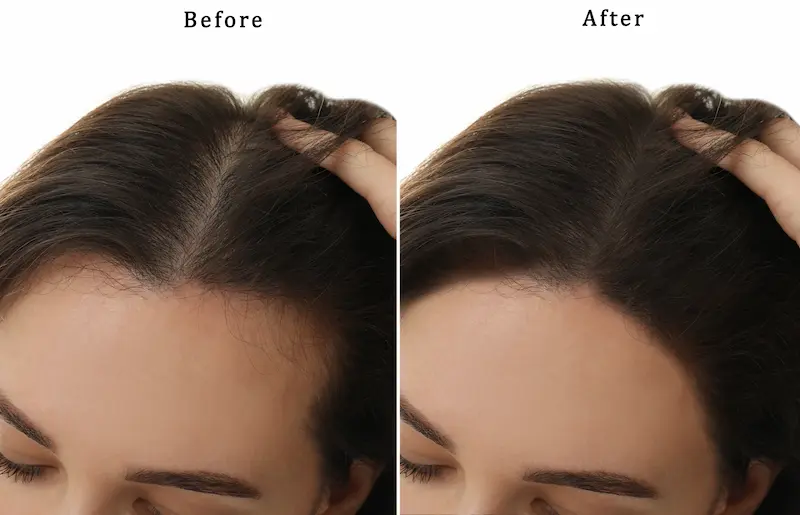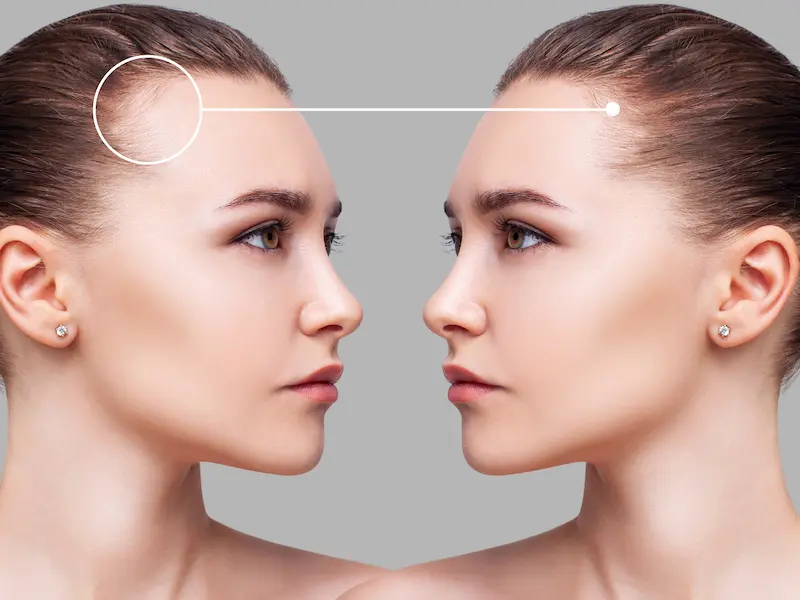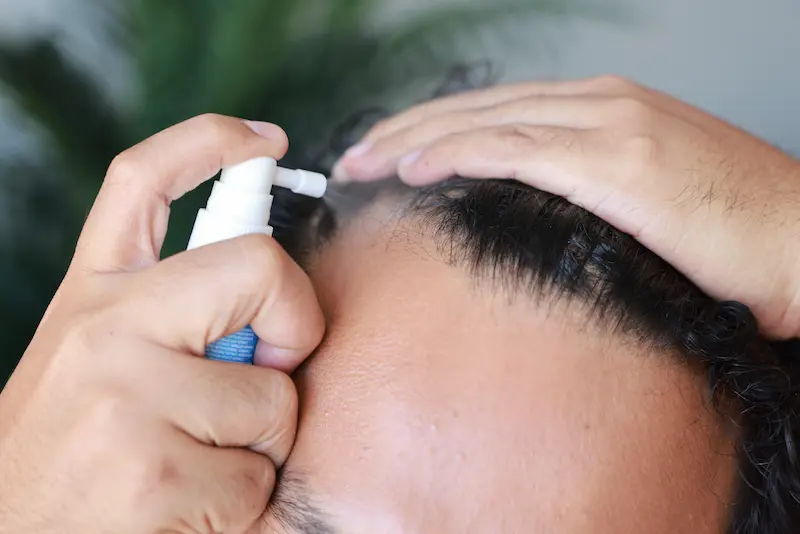Overview
Finasteride is a widely prescribed medication primarily known for its effectiveness in combating hair loss and promoting hair regrowth, especially among men. Marketed under popular brand names such as Propecia and Proscar, finasteride has become one of the cornerstone treatments for male-pattern baldness (androgenetic alopecia) and enlarged prostate (benign prostatic hyperplasia, BPH). However, as with any medication, questions surrounding its safety, effectiveness, and appropriate usage remain prevalent among users and prospective patients alike.
Table of Contents
What Is Finasteride?
Finasteride, chemically classified as a 5-alpha-reductase inhibitor, specifically targets the conversion of testosterone into dihydrotestosterone (DHT). DHT is a powerful androgen hormone that plays a crucial role in male-pattern hair loss and prostate enlargement. By reducing DHT levels in the body, finasteride effectively halts hair loss progression and encourages hair regrowth in many individuals.
Initially introduced to the medical market in the early 1990s for treating prostate conditions, finasteride quickly revealed significant potential for combating hair loss. The lower-dose formulation (1 mg daily) is now commonly used for male-pattern baldness, while higher-dose tablets (5 mg daily) address prostate enlargement.
Finasteride Pharmacology: How the Drug Blocks DHT
The primary pharmacological action of finasteride is to selectively inhibit the enzyme known as type-II 5-alpha-reductase. This enzyme facilitates the transformation of testosterone into DHT, the hormone directly responsible for shrinking hair follicles, resulting in hair thinning and eventual baldness. By blocking this enzyme, finasteride significantly reduces serum and scalp DHT levels, effectively interrupting the hair loss process at its hormonal root.
Clinical evidence demonstrates that finasteride can reduce scalp DHT concentrations by approximately 60-70%. This substantial reduction leads to the stabilization of hair loss and, in many cases, the regrowth of thicker, healthier hair.
Approved Uses & Off-Label Benefits
Officially, finasteride is approved by regulatory agencies like the FDA for two main indications:
- Treatment of male-pattern hair loss (androgenetic alopecia) in men aged 18–41.
- Management of benign prostatic hyperplasia (BPH), characterized by symptoms such as urinary frequency and urgency.
Beyond these approved indications, finasteride has been explored for various off-label uses. Some dermatologists prescribe finasteride to women experiencing hair thinning associated with hormonal imbalances or polycystic ovary syndrome (PCOS). Additionally, anecdotal evidence suggests potential benefits in reducing excessive facial hair growth (hirsutism) in women with hormonal disorders. However, off-label usage requires careful monitoring and physician oversight, particularly due to reproductive health considerations in women.
How Does Finasteride Work to Stop Hair Loss?
Understanding precisely how finasteride stops hair loss is key to appreciating its therapeutic value. The medication’s primary mechanism is hormonal, involving a direct reduction in the concentration of scalp DHT, which is known to miniaturize hair follicles. As follicles shrink, hair growth cycles become shorter, leading to thinner and weaker strands. Eventually, follicles may cease to produce hair altogether, causing visible bald spots.

Finasteride intervenes at the hormonal level to halt and partially reverse this process. By consistently lowering DHT levels, finasteride allows previously affected hair follicles to return to healthier sizes and more prolonged growth cycles. Consequently, existing hair thickens, and dormant follicles often resume hair production, significantly improving hair coverage over time.
Does Finasteride Work? Key Clinical Studies
Numerous clinical studies have rigorously evaluated finasteride’s effectiveness. A notable five-year study involving over 1,800 men with androgenetic alopecia found that nearly 90% of participants who took finasteride maintained or increased their hair count compared to baseline, while placebo users saw continual hair loss. These studies conclusively confirm that finasteride works effectively for a large majority of men when used consistently.
Finasteride vs Placebo: Results You Can Expect
When compared directly against a placebo, finasteride users consistently report better outcomes. Within just 3–6 months of use, many individuals experience significantly reduced hair shedding. By 12 months, substantial improvements in hair thickness, overall density, and scalp coverage become evident. Conversely, placebo groups generally experience ongoing hair thinning and progressive hair loss, underscoring finasteride’s real-world efficacy.
Finasteride vs Minoxidil: Which Treatment Wins?
When faced with hair loss, most individuals inevitably encounter two primary treatments: finasteride and minoxidil. Both medications are popular and FDA-approved, yet they differ significantly in their mode of action, effectiveness, and practical applications. Understanding these differences can help patients select the best option tailored to their specific hair-loss scenario.
Finasteride targets hormonal causes of hair loss by inhibiting the conversion of testosterone to DHT, effectively halting hair follicle miniaturization. It addresses hair loss systemically, meaning it influences hormone levels throughout the body.
Conversely, minoxidil—available as topical foam or solution—works by enhancing blood circulation directly to the scalp. This increased blood flow helps nourish hair follicles, encouraging hair growth without directly affecting hormones.
Combined Therapy for Maximum Regrowth
Interestingly, many dermatologists recommend combining finasteride and minoxidil to achieve superior hair-regrowth outcomes. Clinical research shows that the combined treatment provides synergistic benefits. Finasteride addresses hair loss at its hormonal source, while minoxidil stimulates hair follicles directly at the scalp surface, promoting stronger and faster growth.
In a prominent study involving combination therapy, nearly 94% of participants reported noticeable improvement in hair density and thickness within 12 months, compared to using either medication alone. Such outcomes highlight the advantage of addressing hair loss through multiple pathways simultaneously.
Choosing Between Finasteride and Minoxidil for a Receding Hairline
Selecting between finasteride and minoxidil can be guided by the specific nature of your hair loss, especially when dealing with a receding hairline—a notoriously challenging area to treat.
For frontal hairline recession, finasteride has shown robust clinical efficacy, frequently stabilizing and even partially reversing hairline thinning due to its hormonal intervention. While minoxidil can also help, especially with direct topical application to the receding areas, its results in the hairline are often less predictable than those achieved through systemic DHT reduction.
Patients prioritizing the stabilization and potential restoration of a receding hairline might find finasteride more effective, especially if used early in the hair-loss process. Conversely, minoxidil may be preferable if hormone-based side effects are a significant concern or if patients seek a topical approach.
Oral Finasteride vs Topical Finasteride
Traditionally administered orally, finasteride is now increasingly available in topical formulations. Each form has unique benefits and potential drawbacks, influencing patient preference and treatment outcomes significantly.
Efficacy & Absorption Differences
Oral finasteride is well-established, providing systemic DHT suppression and consistent results. Its broad hormonal impact ensures comprehensive scalp coverage, often translating into predictable and measurable hair growth improvement.
Topical finasteride, on the other hand, directly targets scalp DHT concentrations with minimal systemic absorption. Recent studies indicate topical finasteride can achieve scalp DHT reductions comparable to oral administration, yet with potentially fewer systemic side effects.
However, topical treatments may exhibit variable absorption rates based on skin type, application technique, and the formulation used, leading to somewhat less predictable outcomes compared to oral treatment.
Side-Effect Profiles Compared
One significant benefit of topical finasteride is its potential to reduce the systemic side effects typically associated with oral finasteride, such as lowered libido or erectile dysfunction. Because topical finasteride limits systemic exposure, many individuals report fewer hormonal side effects.
Conversely, oral finasteride, while highly effective, carries a somewhat higher risk of systemic hormonal changes. Though still rare, these risks have prompted individuals sensitive to hormonal fluctuations to consider topical alternatives carefully.
In summary, choosing between oral and topical finasteride requires balancing efficacy, convenience, cost, and individual sensitivity to potential side effects. Those highly concerned about systemic side effects might favor topical formulations, while patients seeking maximal predictable efficacy might prefer oral finasteride or a combined approach.
Does Finasteride Regrow the Hairline?

One of the most common concerns among individuals experiencing hair loss is the recession of the hairline. Known as a hallmark of male-pattern baldness (androgenetic alopecia), a receding hairline presents unique treatment challenges. Finasteride, renowned for its effectiveness in treating overall hair loss, is frequently questioned regarding its capability to specifically restore the hairline. Understanding the scientific evidence around finasteride’s efficacy in regrowing hairlines provides valuable insights into its potential role in your hair restoration journey.
Scientific Evidence for Hairline Density Improvement
Clinical research has shown promising evidence for finasteride’s ability to stabilize and partially reverse a receding hairline. Although results can vary among individuals, studies consistently highlight finasteride’s beneficial impact on frontal and temporal hairline thinning—areas notoriously difficult to treat.
A significant 2-year clinical study involving men with mild to moderate frontal hairline recession demonstrated notable hair regrowth and increased hair density in over 70% of participants. Regular photographic assessments indicated visible improvement in hairline thickness and coverage, particularly when treatment commenced early in the hair-loss process.
While finasteride may not always fully restore a significantly receded hairline to its original state, it reliably stops further progression and often achieves partial restoration, making early intervention critical for optimal results.
Maintenance Strategies After Regrowth
Finasteride’s success depends greatly on consistent long-term usage. Upon achieving satisfactory regrowth of the hairline, maintaining this progress becomes crucial. If the medication is discontinued, DHT levels will gradually return to pre-treatment levels, leading to renewed hair follicle miniaturization and eventual hair thinning.
To sustain hair regrowth, dermatologists commonly recommend continuing finasteride indefinitely at a maintenance dosage. Routine follow-up consultations to monitor progress, regular photographic documentation, and potentially combining finasteride with topical minoxidil treatments can further enhance and maintain hairline density over the long term.
How Long Does Finasteride Take to Work?
Patients frequently wonder how quickly they might observe results once starting finasteride treatment. The timeline for visible improvement can vary based on individual genetic factors, the severity of hair loss, and adherence to treatment guidelines. Nonetheless, finasteride demonstrates a relatively predictable timeline of progression for most users, which provides clear expectations for patients beginning treatment.
Early Signs of Progress (0–3 Months)
During the first three months of treatment, immediate visible regrowth may not be evident, as hair follicles respond gradually to reduced DHT levels. However, many patients notice subtle yet encouraging signs, such as a marked decrease in hair shedding.
Within these initial months, finasteride primarily stabilizes existing hair follicles, reducing hair loss and preventing further deterioration. Patients may notice less hair loss during shampooing, combing, and sleeping, although new hair growth may not yet be evident. At this stage, patience is essential, as continued treatment lays the groundwork for more visible improvements.
Long-Term Results (6–12 Months and Beyond)
Significant visible improvements typically become apparent between six to twelve months of consistent finasteride use. During this period, many patients report measurable increases in hair density and thickness, notably around the crown and frontal hairline. Hair strands become thicker, healthier, and more resistant to shedding, marking an important milestone in treatment progress.
Continued usage beyond the 12-month mark generally leads to further incremental improvements or stable maintenance of achieved results. Long-term clinical data indicate that finasteride remains effective in sustaining hair density for many years, provided it is used consistently.
Regular monitoring, realistic expectations, and adherence to daily dosage guidelines enhance patient satisfaction over the long term, underscoring finasteride’s value as an enduring hair restoration solution.
Finasteride Side Effects & How to Reduce Them
While finasteride is well-established for its effectiveness in halting hair loss and promoting regrowth, like any medication, it carries the potential for side effects. Awareness of these side effects, their prevalence, and effective ways to manage or minimize them is crucial for anyone considering or currently undergoing treatment. Understanding these issues thoroughly can significantly enhance the treatment experience, fostering patient compliance and satisfaction over time.
Common Side Effects Explained
Most side effects associated with finasteride are mild to moderate and tend to improve or resolve once the body adjusts to the medication. However, because finasteride influences hormone levels, particularly DHT, certain side effects related to sexual health and hormonal balance have received attention. The most frequently reported side effects include:
- Sexual dysfunction: Reduced libido, erectile dysfunction, or decreased ejaculatory volume.
- Psychological effects: Anxiety, depression, or mood swings (rare but noted).
- Gynecomastia: Mild breast tissue enlargement or tenderness (less common but documented).
- Allergic reactions: Skin rash, itching, or swelling (extremely rare).
It’s essential to emphasize that these side effects typically affect a small percentage of finasteride users. According to large-scale clinical studies, fewer than 2% of men experience noticeable sexual side effects. Moreover, for most patients experiencing side effects, symptoms subside after stopping treatment or reducing dosage.
Practical Tips to Minimize Finasteride Side Effects
Effectively managing or even preventing side effects associated with finasteride involves several practical strategies that patients can readily implement:
- Lowering dosage: Some individuals benefit from adjusting the standard dosage of finasteride (1 mg daily) to an alternate-day or reduced-dose regimen under physician supervision. Clinical evidence indicates that lower doses may maintain effectiveness while reducing the incidence or severity of side effects.
- Transitioning to topical finasteride: Switching from oral to topical formulations may significantly reduce systemic absorption, thus minimizing hormonal-related side effects. Recent research supports topical finasteride as a viable alternative for patients sensitive to systemic hormonal fluctuations.
- Combined therapy: Pairing finasteride with topical minoxidil may allow patients to achieve hair restoration goals while potentially reducing the necessary dosage of finasteride. A lower dosage often translates into fewer or milder side effects.
- Maintaining a healthy lifestyle: Healthy habits, such as regular exercise, balanced nutrition, and reducing stress, can positively impact hormone balance and overall health. Patients reporting psychological side effects or lowered libido may find these lifestyle adjustments particularly beneficial.
Is Finasteride Safe? Understanding Long-Term Risks
Long-term safety is understandably one of the primary concerns for patients starting any chronic medication. Due to its hormonal mechanism, finasteride often raises questions about potential impacts on testosterone levels, fertility, and sexual health. Comprehensive research data provide valuable insights into these long-term safety considerations.
Does Finasteride Reduce Testosterone? Myth vs Reality
A common misconception surrounding finasteride usage is that it significantly lowers testosterone levels. In reality, finasteride does not directly decrease testosterone production; rather, it inhibits its conversion to DHT. Clinical studies show that serum testosterone levels may actually rise slightly (typically by around 10-15%) in men taking finasteride, as testosterone is no longer converted to DHT as extensively. However, these mild fluctuations generally remain within normal physiological ranges and typically do not negatively impact health or well-being.
Fertility & Sexual Health Considerations
Concerns around fertility often surface among men considering finasteride treatment. However, substantial clinical data indicate that finasteride generally does not adversely affect sperm count, motility, or overall fertility in healthy males. Although isolated case reports of reduced sperm quality exist, such occurrences remain extremely rare and reversible upon cessation of treatment.
Nevertheless, given the sensitive nature of sexual health, men actively attempting conception should consult healthcare providers before initiating finasteride. Regular follow-ups, periodic evaluations, and open communication with a healthcare provider ensure ongoing treatment aligns with patients’ reproductive goals and overall well-being.
Finasteride for Women: Can Women Use It Safely?
Although primarily marketed toward men, finasteride has increasingly gained attention as a potential hair-loss solution for women experiencing androgenetic alopecia or hormone-related thinning. However, due to significant hormonal differences between men and women, careful evaluation of finasteride’s safety, effectiveness, and recommended dosage for female patients is essential. Understanding these factors helps women make informed decisions regarding finasteride use, ensuring safe and effective treatment outcomes. — Also check Female Hair Transplant.
Recommended Dosages & Monitoring
Finasteride usage in women is typically considered off-label, meaning it is not explicitly approved by regulatory agencies like the FDA for female hair loss. Nonetheless, several clinical studies indicate potential effectiveness, particularly for women experiencing hair thinning due to hormonal imbalances, menopause, or conditions like polycystic ovary syndrome (PCOS).
When prescribed, women typically use finasteride at lower doses (around 1 mg daily or even less), under close medical supervision. Continuous monitoring, including regular hormone tests, is crucial to detect any potential imbalances early, allowing timely intervention or dosage adjustment.
Pregnancy & Breastfeeding Precautions
Finasteride use is strictly contraindicated during pregnancy and breastfeeding due to the risk of birth defects. The drug can cause abnormalities, particularly affecting male fetal development. Women of childbearing age who consider finasteride must implement reliable contraception methods and undergo regular pregnancy testing to prevent unintended exposure.
It’s also important for women to avoid any physical contact with broken or crushed finasteride tablets, as skin absorption could theoretically pose similar risks. Clear warnings and diligent adherence to guidelines help prevent accidental exposure and ensure safe use among female patients.
FAQs
One of the most frequently asked questions involves stopping finasteride after achieving satisfactory hair regrowth. While it might seem logical to discontinue the medication once results appear, halting treatment generally leads to a gradual recurrence of hair loss. As DHT levels rebound, hair follicles resume miniaturization, causing renewed hair thinning over several months.
To maintain results, continuous treatment at a maintenance dose is typically necessary. Patients considering discontinuation should discuss options with their healthcare provider to minimize potential hair loss upon stopping or explore alternative maintenance treatments.
Missing an occasional dose of finasteride generally does not significantly impact overall treatment efficacy. The drug remains active in the body for approximately 24 to 48 hours, providing temporary coverage. If a dose is forgotten, patients are advised simply to resume their regular dosing schedule the next day without doubling the dose.
Consistent daily use ensures optimal long-term results. Developing a routine, such as taking finasteride at the same time each day or setting daily reminders, can significantly enhance adherence and overall effectiveness.


